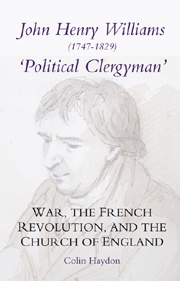 John Henry Williams (1747–1829): 'Political Clergyman'
John Henry Williams (1747–1829): 'Political Clergyman' Book contents
- Frontmatter
- Contents
- Dedication
- Illustrations
- Preface and Acknowledgements
- Abbreviations
- Editorial Note
- 1 The Grave and the Memory
- 2 The Formative Years
- 3 The Ivy-mantled Tow'r: Parish and Pastoralia
- 4 The Gathering Storm
- 5 By Far the Heaviest of All Earthly Calamities: Williams' Anti-War Sermons
- 6 Anxiety, the 1797 Campaign, and Afterwards
- 7 Assessment
- Bibliography
- Index
- STUDIES IN MODERN BRITISH RELIGIOUS HISTORY
3 - The Ivy-mantled Tow'r: Parish and Pastoralia
Published online by Cambridge University Press: 12 September 2012
- Frontmatter
- Contents
- Dedication
- Illustrations
- Preface and Acknowledgements
- Abbreviations
- Editorial Note
- 1 The Grave and the Memory
- 2 The Formative Years
- 3 The Ivy-mantled Tow'r: Parish and Pastoralia
- 4 The Gathering Storm
- 5 By Far the Heaviest of All Earthly Calamities: Williams' Anti-War Sermons
- 6 Anxiety, the 1797 Campaign, and Afterwards
- 7 Assessment
- Bibliography
- Index
- STUDIES IN MODERN BRITISH RELIGIOUS HISTORY
Summary
The Setting
It is unclear whether, in 1778, Williams envisaged spending the rest of his life in south Warwickshire. It is possible that he developed reservations about resubscribing to the Thirty-Nine Articles and that, since resubscription would have been required had he obtained significant preferment, he became content to remain at Wellesbourne. But there is evidence that, as late as 1807, he hoped for a more lucrative and more prestigious living. Nonetheless, he doubtless found Wellesbourne and its locality congenial.
During the eighteenth and early nineteenth centuries, south Warwickshire became increasingly sophisticated. Its towns prospered and developed leisure facilities; and Williams no doubt appreciated both the various urban amenities and meeting persons of quality in refined and attractive settings. Warwick was only eight miles from Wellesbourne, and had been rebuilt after its disastrous fire of 1694 in a ‘noble and … beautiful … manner’, with wide, well-paved, and well-lit streets. Its surviving medieval buildings, notably the Castle and St Mary's church, contrasted pleasantly with its fine eighteenth-century public buildings and the ‘modern and handsome’ private houses. It further boasted its races, public library, good shops, pleasant inns, and a weekly newspaper; unsurprisingly, it attracted noble and gentry visitors. Still nearer to Wellesbourne was Stratford-upon-Avon, a ‘neat and well-built’ town, with its mixture of ‘curious’ old houses and handsome Georgian architecture, and several good inns, notably the White Lion, the Warwickshire hunt's home in the late eighteenth century.
- Type
- Chapter
- Information
- John Henry Williams (1747–1829): 'Political Clergyman'War, the French Revolution, and the Church of England, pp. 37 - 62Publisher: Boydell & BrewerPrint publication year: 2007


